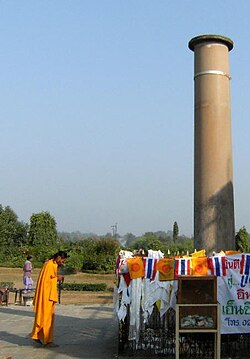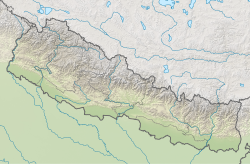Lumbini
Lumbini
लुम्बिनी | |
|---|---|
 | |
 Lumbini Location of Lumbini in Nepal | |
| Coordinates: 27°28′53″N 83°16′33″E / 27.48139°N 83.27583°E | |
| Country | Nepal |
| Province | Lumbini Pradesh |
| District | Rupandehi |
| Municipality | Lumbini Sanskritik |
| Government | |
| • Type | Development trust |
| • Body | Lumbini Development Trust |
| Elevation | 150 m (490 ft) |
| Time zone | UTC+05:45 (NST) |
| Postal Code | 32914 |
| Website | www |
| UNESCO World Heritage Site | |
|---|---|
| Location | Rupandehi District, Nepal |
| Criteria | Cultural: iii, vi |
| Reference | 666 |
| Inscription | 1997 (21st Session) |
| Area | 1.95 ha |
| Buffer zone | 22.78 ha |
| Coordinates | Coordinates: 27°28′53″N 83°16′33″E / 27.48139°N 83.27583°E |
Lumbinī (Nepali and Sanskrit: लुम्बिनी pronounced [ˈlumbini] (![]() listen), "the lovely") is a Buddhist pilgrimage site in the Rupandehi District of Lumbini Province in Nepal. It is the place where, according to Buddhist tradition, Queen Mahamayadevi gave birth to Siddhartha Gautama at around 563 BCE.[1][2] Gautama, who achieved Enlightenment some time around 528 BCE,[3][4] became the Buddha and founded Buddhism.[5][6][7] Lumbini is one of many magnets for pilgrimage that sprang up in places pivotal to the life of the Buddha.
listen), "the lovely") is a Buddhist pilgrimage site in the Rupandehi District of Lumbini Province in Nepal. It is the place where, according to Buddhist tradition, Queen Mahamayadevi gave birth to Siddhartha Gautama at around 563 BCE.[1][2] Gautama, who achieved Enlightenment some time around 528 BCE,[3][4] became the Buddha and founded Buddhism.[5][6][7] Lumbini is one of many magnets for pilgrimage that sprang up in places pivotal to the life of the Buddha.
Lumbini has a number of older temples, including the Mayadevi Temple, and various new temples, funded by Buddhist organisations from various countries, have been completed or are still under construction. Many monuments, monasteries and a museum, and the Lumbini International Research Institute are also within the holy site. Also, there is the Puskarini, or Holy Pond, where the Buddha's mother took the ritual dip prior to his birth and where he had his first bath. At other sites near Lumbini, earlier Buddhas were, according to tradition, born, then achieved ultimate Enlightenment and finally relinquished their earthly forms.
Lumbini was made a World Heritage Site by UNESCO in 1997.[1][2]
In Buddha's time[]
In the Buddha's time, Lumbini was situated in east of Kapilavastu and southwest Devadaha of Shakya, an oligarchic republic.[8][9] According to Buddhist tradition, it was there, that the Buddha was born.[10] A pillar discovered at Rupandehi in 1896 is believed to mark the spot of Ashoka's visit to Lumbini. The site was not known as Lumbini before the pillar was discovered.[11] The translation of Inscription reads:[12] "When King Devanampriya Priyadarsin had been anointed twenty years, he came himself and worshipped (this spot) because the Buddha Shakyamuni was born here. (He) both caused to be made a stone bearing a horse (?) and caused a stone pillar to be set up, (in order to show) that the Blessed One was born here. (He) made the village of Lummini free of taxes, and paying (only) an eighth share (of the produce)."[13] The park was previously known as Rupandehi, 2 mi (2 mi (3.2 km)) north of Bhagavanpura.
The Sutta Nipáta (vs. 683) states that the Buddha was born in a village of the Sákyans in the Lumbineyya Janapada. The Buddha stayed in Lumbinívana during his visit to Devadaha and there preached the Devadaha Sutta.[14]
Pillar of Ashoka[]
In 1896, General Khadga Samsher Rana and Alois Anton Führer discovered a great stone pillar at Rupandehi, according to the crucial historical records made by the ancient Chinese monk-pilgrim Xuanzang in the 7th century CE and by another ancient Chinese monk-pilgrim Faxian in the early 5th century CE. The Brahmi inscription on the pillar gives evidence that Ashoka, emperor of the Maurya Empire, visited the place in 3rd-century BCE and identified it as the birth-place of the Buddha. The inscription was translated by Paranavitana:[15][note 1]
| Translation (English) |
Transliteration (original Brahmi script) |
Inscription (Prakrit in the Brahmi script) |
|---|---|---|
|
|

